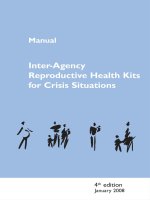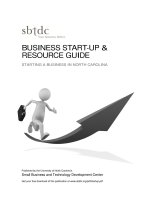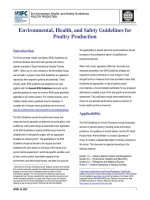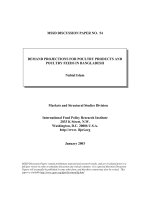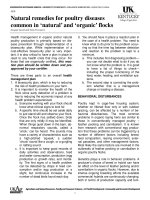Crop Profile for Poultry in North Carolina pdf
Bạn đang xem bản rút gọn của tài liệu. Xem và tải ngay bản đầy đủ của tài liệu tại đây (142.11 KB, 12 trang )
Crop Profile for Poultry in North Carolina
Prepared: April 1999
Revised: November 1999, June 2005
General Production Information
● In 2003, North Carolina ranked third nationally in poultry and egg product cash receipts ($2.2
billion), representing 9.5% of the U.S. production. Poultry and egg production accounted for
31.8% of farm income in North Carolina in 2003.
● In 2003, North Carolina ranked second nationally in the number of turkeys raised (42.5 million
head), representing 15.5% of U.S. production.
● In 2003, North Carolina ranked fourth nationally in the number of broilers produced (708 million
head), representing 8.6% of U.S. production.
● In 2003, North Carolina ranked ninth nationally in the number of non-broiler chickens (17.5
million head), representing 3.9% of U.S. production.
● In 2003, North Carolina ranked tenth nationally in the value of eggs produced ($242 million),
representing 4.5% of U.S. production.
Production Regions
Chicken production (layers, broiler breeders, and broilers) essentially extends from Gates, Pitt, Craven,
and Pender counties in the east to Cleveland, Burke, Caldwell, and Ashe counties in the west. North
Carolina’s turkey production region follows a similar east to west distribution but extends no farther
north than Pitt, Chatham, and Iredell counties. There are two distinct areas of concentrated turkey
production within this region: an eastern area centered around Sampson, Duplin, and Wayne counties
and a western area centered around Union, Anson, and Stanly counties. Figures 1, 2 and 3 include the
primary broiler, chicken (except commercial broilers) and turkey-producing counties, respectively, in
North Carolina.
Figure 1. Primary broiler-producing counties in North Carolina, including Wilkes, Union, Randolph,
Chatham, Moore, Duplin, Richmond, Harnett, Anson and Bertie counties.
Figure 2. Primary chicken (excluding commercial broilers) producing counties in North Carolina,
including Alexander, Nash, Iredell, Union, Randolph, Yadkin and Wilkes counties.
Figure 2. Primary turkey-producing counties in North Carolina, including Sampson, Duplin, Wayne,
Union, Onslow, Lenoir, Greene, Bladen, Pender and Stanly counties.
Cultural Practices
Commercial poultry production is predominantly a vertically integrated system in North Carolina.
Production companies (integrators) contract with growers to produce birds or eggs. In general, the
integrator supplies birds and feed, and often supplies supplemental materials such as medications,
pesticides, etc. The integrator is also responsible for hatchery management, transport, slaughter, and
marketing. The grower builds and maintains the houses, installs and maintains equipment, handles daily
flock management, and disposes of dead birds and waste.
Birds are housed in large structures with floor areas ranging from 12,000 square feet to more than
20,000 square feet. Buildings have automated feeders and either bell-type, nipple, or cup watering
systems. Broilers and turkeys are raised on deep litter (wood shavings) in open-floor environments
where birds can move freely throughout the house. A production cycle for broilers generally lasts six
weeks, after which birds are removed to market. A new flock of day-old broilers is placed in the broiler
house within two to four weeks, allowing time for the grower to clean and disinfect the building. Turkey
production schedules and methods are somewhat different. Young turkeys are most often placed in
brooder houses for the first six weeks of their lives, after which they are moved to grow-out houses until
they are sold to market after another 12 to 18 weeks of growth. A two- to four-week period is allowed
before a new flock is placed in either turkey brooder or grow-out houses to allow for cleaning and
disinfection. Wastes (manure mixed with litter) are generally removed from turkey grow-out houses
once a year. Old litter is generally replaced after each flock is removed from turkey brooder houses. The
trend for waste removal in broiler houses has shifted from annual cleanouts to once every 2 or more
years.
Broiler-breeder hens are first housed in open-floor environments or pens where they are reared to 20 to
22 weeks of age. The arrangement and management of these houses are similar to that described for
broilers. Roosters are similarly housed until breeding age. The breeding flock (hens and roosters) is then
transferred to production houses where hens begin to lay fertile eggs at about 24 weeks of age. The birds
are held in production for an additional 36 to 44 weeks, at which time they are sold to the market.
Production broiler-breeder flocks are confined in modified open-floor housing, where two thirds of the
space (along walls) consists of a raised, slatted floor. Most of the manure collects beneath these slats.
The remaining central portion of the floor (scratch area) consists of deep litter. Water and feed lines are
located over the slatted area of the house. Automated nest boxes are positioned down the length of the
house along the raised slats on both sides of the scratch area. Once the broiler-breeder flock is removed,
nest boxes and slats are taken from the building to allow a thorough cleanout. Manure and litter are
removed, the building and equipment are washed and disinfected, and the system of slats and nest boxes
is reinstalled for a new flock of birds. Several months often elapse between flocks.
Layer pullets are first placed in cages or open-floor environments for six to eight weeks. Floor-reared
birds are transferred to rearing cages until ready for production. All layer pullets are then reared in cages
until they are 18 to 20 weeks of age, after which they are transferred to production housing. Laying
flocks are held in production until about 75 weeks of age. Commercial layers are confined to cages
(three to four birds per cage) within buildings. Rows of cages are most often tiered three to four cages
high, each tier slightly offset from the one below to prevent droppings from contaminating the birds in
lower cages. Four to eight rows of tiered cages extend the length of the house. Rows are arranged back
to back so that three to five walkways can be used for inspection and maintenance. Automated feeders
and cup or nipple drinkers provide food and water to each cage. An automated egg-handling system
collects eggs as they are laid. Manure may be allowed to collect in a deep pit beneath cages, or it may be
flushed into a lagoon. Manure collected in deep-pit designs (high-rise housing) accumulates until the
layer flock is removed; liquid waste-handling systems are flushed daily. The cleanout interval between
flocks is similar to that for broiler breeders, although the cages and equipment are generally left in place
while the building is cleaned and disinfected.
Worker Activities
Risks associated with pesticide application in poultry production are greatest during handling and
mixing of concentrates prior to application. Spills and splash during mixing and airborne particulates
while loading applicators are the most likely exposure events. As with mixing and loading, dermal, oral
and inhalation exposure during premise treatment are also possible. Exposures due to splash and aerosol
drift are highest during application of high-pressure sprays (75 to 100 psi) used to suppress difficult to
control pests, and dust treatments using high volume, power applicators. Exposure risks during premise
treatment are reduced where low-pressure application (less than 50 psi) is prescribed, and where dust
application is limited to litter surfaces using gravity fed equipment.
Control of ectoparasites on poultry creates additional exposure risks. High pressures sprays or dipping
are often used in large commercial operations to treat birds for obligate ectoparasites such as the
northern fowl mite. Aerosol and splash represent exposure risks for the applicator in both situations.
Routes of entry may be oral, dermal or inhalation. Dipping represents the most significant risk to
personnel since each bird must be handled to effectively treat the outbreak. A significant amount of
splash occurs as birds are immersed and withdrawn from the dipping vat. Commercial flocks are seldom
treated with dusts to control ectoparasites. Pesticide impregnated plastic strips are sometimes used in
place of spray or dip treatments. These devices are hung in cages or nest boxes, allowing the birds to
self-apply the active ingredient as they brush against the ribbons. Dermal and oral exposure risks are of
possible concern for individuals hanging these devices, primarily because individuals handle a large
number of strips during installation.
Pesticide exposure to residues on surfaces, eggs and birds are minimal, representing little risk to
workers. Once treated, birds are seldom handled by workers until removed from the houses at the end of
a production cycle. Frequency of application also plays a role in reducing secondary exposure following
premise treatments. Poultry houses are often treated just prior to the introduction of a new flock. In the
case of broilers and young turkeys, premise treatments will occur at a minimum of every 7 to 8 weeks.
Treatment intervals in turkey grow-out houses are approximately twice that of broilers, and intervals for
breeder and layer operations can extend from greater than 40 weeks to more than 1 year. Where
exposure to large areas of treated surface occurs, as in open floor production systems for broilers and
turkeys, the primary contact point is the litter. The highly reactive chemical and biological environment
of poultry litter and manure degrades many of the labeled pesticides within 1 to 2 weeks. Manure that
accumulates beneath slats in broiler breeder houses or in the pit area of high-rise layer houses is
sometimes treated with larvicides (pesticides or insect growth regulators). Because workers and birds
are not in direct contact with the wastes, there is little risk of secondary exposure. Exposure risks are
also minimal when the manure is removed from these houses since decomposition processes will have
eliminated much of the applied pesticide. However, some insect growth regulators (IGR’s) may persist
in the manure through the cleanout phase.
All of the worker exposure risks discussed here are significantly reduced by the use of recommended
protective equipment and safe procedure during mixing, loading and application.
Insect Pests
Two broad categories of pests affect poultry: ectoparasites – mites and insects living and/or feeding on
poultry (mites, lice, bed bugs); and structural or environmental pests – flies, mosquitoes, litter beetles,
dermestid beetles, cockroaches, spiders, and red imported fire ants. This latter category of pests,
associated with the environment of modern confinement poultry production, directly damages poultry
structures, is a potential or documented vector of disease and avian parasites, or is a source of nuisance.
Ectoparasites
These pest infestations are infrequent and typically limited to breeding flocks or layers. Broilers and
market turkeys are seldom if ever affected. Management of ectoparasites largely consists of whole flock
treatments whenever infestations are detected by scouting birds and/or inspection of the structure and
equipment (nest boxes, curtains, slats, cages). Other effective management techniques are not available.
It is estimated that slightly more than 4 percent of breeder birds and layers are treated for ectoparasites
each year. Pesticides are applied directly to the birds for control of northern fowl mites and poultry lice.
The average number of treatments applied directly to birds ranges from 1.2 to 5.5. Premise treatments
are most often applied to control red chicken mites, bed bugs, and poultry lice. Permethrin, pyrethrins,
tetrachlorvinphos, and RaVap (dichlorvos + tetrachlorvinphos) are applied to the birds as well as the
premises. Dichlorvos is occasionally used as a flushing agent/toxicant space spray for bed bugs.
Cyfluthrin may also be used as a premise treatment to control bed bugs as long as birds are not present.
Varying levels of pyrethroid resistance in fowl mites is prevalent in the United States. Resistance in
poultry lice and bed bugs appears to be minimal, but is of equal concern. The availability of
tetrachlorvinphos and dichlorvos as alternative treatments is therefore essential to manage resistance
unless new classes of compounds become available.
Structural and Environmental Pests
This category of pests is widespread and affects every stage of poultry production to a greater or lesser
extent. The house fly (Musca domestica) and other fly species with similar biology and habits can
generally be managed with minimal use of pesticides where appropriate cultural and biological control
practices are most effective (broiler breeders and layers). Manure management to reduce moisture
reduces fly-breeding potential and enhances the effectiveness of naturally occurring fly parasites and
predators. Releases of beneficial insects (primarily parasitic wasps) can also be effective in the control
of flies in broiler-breeder and layer operations. Trapping is useful where fly populations are relatively
low. However, manure moisture and biological control are difficult to manage throughout an entire flock
cycle. Traps are difficult to maintain and are quickly overwhelmed when other elements of the
management system fail. Failures occur frequently and require the use of insecticides to reduce fly
populations. More than half (54 percent) of producers are estimated to use insecticides to control a
variety of dipteran pests.
Other pests such as the darkling beetle (Alphitobius diaperinus) and the dermestid beetle (Dermestes
maculatus) are also prevalent in poultry houses. Darkling beetles are by far the most serious problem,
prompting approximately 81 percent of producers to apply pesticides for beetle control. The red
imported fire ant, spiders, mosquitoes, and cockroaches may also infest poultry houses and account for a
little more than 10 percent of the pesticides applied. Cultural and biological control practices are largely
ineffective for these pests, requiring between-flock application of insecticides to control their
populations.
Insecticides used to control some or all of these structural/environmental pests include those already
mentioned (tetrachlorvinphos, dichlorvos, permethrin, pyrethrin, and cyfluthrin), as well as chlorpyrifos,
lambda-cyhalothrin, esfenvalerate, orthoboric acid, methomyl, cyromazine, pyriproxyfen, imidacloprid
and nithiazine. Carbaryl has lost its registration for use inside poultry houses, and so is of little practical
value to the industry.
Pyrethroid insecticide resistance in house flies is well documented in the United States. However, the
extent to which it occurs in North Carolina poultry production has not been quantified. Pyrethroid
resistance among other structural/environmental pests is not believed to be substantial at present, but
recent investigations in other poultry producing states indicate the lesser mealworm, Alphitobius
diaperinus, has significant levels of resistance to cyfluthrin and tetrachlorvinphos. Because this
compound has been a mainstay of lesser mealworm control in North Carolina, it is likely that a similar
resistance profile exists here. New, restrictive labeling for carbaryl has effectively removed its value for
poultry growers as a premise treatment. The availability of tetrachlorvinphos, dichlorvos, and
chlorpyrifos are believed to be more essential than ever to control key premise pests. The limited
catalog of effective pesticides that presently exists is a primary concern for the North Carolina poultry
industry. The introduction of new classes of compounds for use in poultry production is minimal and
for pests where no effective management alternatives other than pesticides exist, the outlook for new and
economical options for managing resistance is not promising.
Chemical Controls
Chlorpyrifos (Duratrol)
This product is available as a microencapsulated concentrate. Use patterns have not been established for
premise treatments to control flies, beetles, and other pests. Treatment is applied as a premise fog or
spray at a rate of 1 gallon of spray (0.04 pound of active ingredient) per 1,000 square feet of surface.
Dichlorvos (Vapona)
This material is available as an emulsifiable concentrate. Treatments are most often used for fly control.
Occasionally, dichlorvos is applied to control ectoparasites during cleanup routines following the sale of
an infested breeder or layer flock. It is applied as either a space spray (0.001 pound of active ingredient
per 1,000 cubic feet) or as a premise spray (0.01 pound of active ingredient per 1,000 square feet of
surface area). Dichlorvos is occasionally used as a spot larvicide treatment for fly control at a rate of
0.002 to 0.02 pound active ingredient per 100 square feet of manure beneath slats, cages, and drinkers.
An estimated 802,000 square feet (0.4 percent) of premise area are treated with dichlorvos.
Dimethoate (Cygon)
Poultry and other animal use registrations for this active ingredient have been cancelled.
Malathion
Available primarily as an emulsifiable concentrate and dust, malathion is used as a premise treatment on
approximately 6 percent (12 million square feet) of poultry house area by North Carolina producers.
Premise treatments are applied for fly and beetle control at a rate of 0.08 to 0.2 pound of active
ingredient per 1,000 square feet of surface area. Dust formulations are applied at about 0.8 pound of
active ingredient per 1,000 square feet. The status of malathion is not yet clear, but many livestock and
poultry uses have been voluntarily cancelled. All indications are that livestock and poultry labeling will
be withdrawn by the remaining manufacturers by 2006.
Tetrachlorvinphos (Rabon)
Available as a dust and wettable powder, Tetrachlorvinphos is applied to about 18 percent of the birds
treated for ectoparasites and 10 percent of premise area (20 million square feet) to control various pests.
Treatments are generally applied as high-pressure sprays at a rate of 1 gallon of spray (0.04 pound of
active ingredient) spray per 100 birds. Premise applications for a variety of pests are made at a rate of
0.05 to 0.8 pound of active ingredient per 1,000 square feet of surface area. Dust formulations are
applied to birds (dust boxes) at a rate of 0.01 to 0.2 pound of active ingredient per 100 birds, and to
premises for ectoparasites and beetles at a rate of 0.05 to 0.2 pound active ingredient per 1,000 square
feet of surface area. Rabon is occasionally used as a spot larvicide treatment for fly control at a rate of
0.08 pound of active ingredient per 100 square feet of manure beneath slats, cages, and drinkers.
Tetrachlorvinphos + dichlorvos (RaVap)
Available as an emulsifiable concentrate, RaVap is applied to approximately 10 percent of the birds
treated for ectoparasites and 7 percent of premise area (14 million square feet) for a variety of pests.
Treatments are applied as high-pressure sprays at a rate of 0.04 pound tetrachlorvinphos + 0.01 pound
dichlorvos per 100 birds. Premise applications are made at a rate of 0.04 + 0.01 pound to 0.08 + 0.02
pound of active ingredient per 1,000 square feet of surface area for a variety of pests in poultry houses.
RaVap is occasionally used as a spot larvicide treatment for fly control at a rate of 0.08 + 0.02 pound
active ingredient per 100 square feet of manure beneath slats, cages, and drinkers.
Trichlorfon (Dipterex)
No longer used for fly control in poultry. Registered only as a formulation product.
Methomyl (Apache, Golden Malrin)
Available as a bait for fly control, methomyl is used as a scatter bait or in fly traps at a rate of 0.005
pound active ingredient per 1,000 square feet. Estimated usage has dropped by half to less than 150,000
square feet of treated area due to the introduction of nithiazine and imidacloprid bait products.
Cyfluthrin (Tempo, CountDown, Optem)
This material is available as dust, wettable powder, and flowable. Cyfluthrin has largely replaced many
insecticides previously used for darkling beetle control. Premise treatments are applied at a rate of 0.004
to 0.008 pound active ingredient per 1,000 square feet of surface area. Dust formulations (0.1 percent)
are applied at 0.02 and 0.05 pound of active ingredient per 1,000 square feet of surface area.
lambda-cyhalothrin (Grenade, Commodore)
This material is available as a wettable powder and microencapsulated concentrate. Used primarily for
fly control in poultry houses, cyhalothrin is applied as a premise spray at a rate of 0.001 to 0.01 pound
active ingredient per 1,000 square feet of surface area.
Permethrin (various trade names)
Available as a dust, wettable powder, and emulsifiable concentrate, permethrin is used on more than 10
percent of the birds (layers, breeders, pullets) treated for ectoparasites. Treatment is most often applied
to birds at a rate of 1 gallon of spray (0.004 pound of active ingredient) spray per 100 birds. Premise
application at the same concentration is made at a rate of 1 to 2 gallons spray per 1,000 square feet of
surface area. Dust formulations (0.25 percent) are applied to birds (dust boxes) and premises (litter) at a
rate of 1 pound (0.003 pound of active ingredient) per 100 birds or 10 pounds (0.03 pound of active
ingredient) per 1,000 square feet of litter surface, respectively. Premise treatments for fly and beetle
control are applied at a rate of 0.01 to 0.05 pound of active ingredient per 1,000 square feet of surface
area. Space sprays for fly control are applied at approximately 0.001 to 0.006 pound of active ingredient
per 1,000 cubic feet of volume.
Permethrin is applied to approximately 17 percent (34.1 million square feet) of area in North Carolina
poultry houses to control a variety of pests.
Pyrethrins (various trade names)
Available primarily as an emulsifiable concentrate, these materials are used mainly as space sprays for
fly control. About 6 million square feet of the area in North Carolina poultry houses (3 percent) are
treated with pyrethrins. The insecticide (synergized with PBO) is generally applied at a rate of 0.0002 to
0.001 pound of active ingredient per 1,000 cubic feet of volume. It is used to treat 6 percent of breeders
and layers for mites and lice at a rate of approximately 0.01 pound of active ingredient per 100 birds.
Orthoboric acid (SafeCide)
Available primarily in dust formulations and used for the control of darkling beetles, boric acid is
applied at a rate of approximately 10 to 20 pounds active ingredient per 1,000 square feet of floor area.
The material may also be applied as a spray at the same rate. The product is little used by producers
largely due to unpredictable efficacy.
Cyromazine (Larvadex, CyFly)
Available as feed additive and soluble liquid, cyromazine is used for the control of flies in broiler
breeders, layers, and pullets. The feed additive is administered at 0.01 pound of active ingredient per ton
of feed for a period of 4 to 6 weeks per treatment cycle. The liquid formulation is applied to manure
beneath slats or cages at a rate of approximately 0.01 pound of active ingredient per 100 square feet.
Cyromazine is used for fly control in slightly more than 76 percent of breeders and layers each year,
primarily at the start of a flock cycle when fly suppression is most difficult. More accurately, the
material is used for only about 8 weeks per flock cycle of 44 to 72 weeks.
Nithiazine (QuikStrike)
Formulated as an insecticidal strip and used for fly control, nithiazine strips (1 percent) are hung in
poultry buildings. The recommended placement density of 1 strip per 100 to 300 square feet is seldom
used due to the size of production houses (16,000 to 24,000 square feet) and cost per strip. Typical
placement is 1 strip per 1,000 to 1,500 square feet.
Carbaryl (Sevin)
Label changes for carbaryl have rendered this insecticide irrelevant for poultry producers. All uses for
on-bird application have been withdrawn. Restrictions limiting premise treatment to building exteriors
makes the compound of little or no value for control of primary structural pests such as the lesser
mealworm.
Pyriproxyfen (Pyri-Shield)
Available as a 1.3% emulsifiable concentrate, this insect growth regulator (IGR) is primarily used as a
broadcast or spot applied treatment (1 fluid ounce per 1,500 square feet) for the control of fly larvae by
an estimated 1% of caged layer and broiler breeder operations. It is also used in tank mixes (1 fluid
ounce per 1,000 square feet) with insecticides used to control lesser mealworms by approximately 10%
of the state’s poultry operations.
Imidacloprid (QuickBayt)
Available as a 0.5% bait, imidacloprid is used as a scatter bait (.002 pounds active ingredient per 1,000
square feet). The product may also be mixed with water and applied to fly resting sites on walls as a
paint-on. The bait is a relatively new introduction into the market, but has replaced the use of methomyl
baits on approximately 150,000 square feet of poultry housing.
Esfenvalerate (Endure)
Available primarily as a 35% wettable powder formulation, esfenvalerate is used infrequently for house
fly and litter beetle control.
Current Insecticide and Miticide Recommendations for Poultry
Current North Carolina Cooperative Extension Service recommendations for insecticide and miticide
use on poultry (including information on formulations, application rates, and precautions/limitations) are
provided in the following table from the North Carolina Agricultural Chemicals Manual:
Table 5-13E: Insect Control for Livestock and Poultry – Poultry
/>
Contacts
S. Michael Stringham
Extension Specialist (Livestock and Poultry IPM)
Department of Entomology
North Carolina State University
Campus Box 7626
Raleigh, NC 27695
Telephone: (919) 515-8878
E-mail:
D. Wesley Watson
Extension Specialist (Livestock and Poultry IPM)
Department of Entomology
North Carolina State University
Campus Box 7626
Raleigh, NC 27695
Telephone: (919) 513-2028
E-mail:
Donna K. Carver
Extension Specialist (Poultry Veterinarian)
Department of Poultry Science
North Carolina State University
Campus Box 7608
Raleigh, NC 27695
Telephone: (919) 515-5526
E-mail:
References
1. Sherrell, E. M. (ed.). 2004. North Carolina Agricultural Statistics 2004. Publication No. 204.
North Carolina Department of Agriculture & Consumer Services, Raleigh.
2. Toth, S. J., Jr. 1996. A Survey of Pesticide Use on Poultry and Tomatoes in North Carolina. Part
II: Poultry. Data report to the USDA National Agricultural Pesticide Impact Assessment
Program. June 1996. North Carolina Cooperative Extension Service.
3. Toth, S. J., Jr., S. M. Stringham and D. W. Watson. 2002. Poultry Pesticide Use Survey in North
Carolina. Data report submitted to the Southern Region Pesticide Impact Assessment Program,
February 15, 2002. North Carolina Cooperative Extension Service, Raleigh.
4. 1992 Poultry Pest Management Manual. North Carolina Cooperative Extension Service. AG-474.
5. External Parasites and Poultry Pests, in Diseases of Poultry, 9th edition.
6. Parkhurst, C. R., and G. J. Mountney. Poultry Meat and Egg Production.
7. Austic, R. E., and M. C. Nesheim. Poultry Production, 13th edition.
On-Line Resources
Fly Problems Around Poultry, Livestock and Horse Farms
/>Poultry, Livestock Commodity of North Carolina
/>
Prepared by:
Stephen M. Stringham, David W. Watson, Donna K. Carver and Stephen J. Toth, Jr. (ed.)

